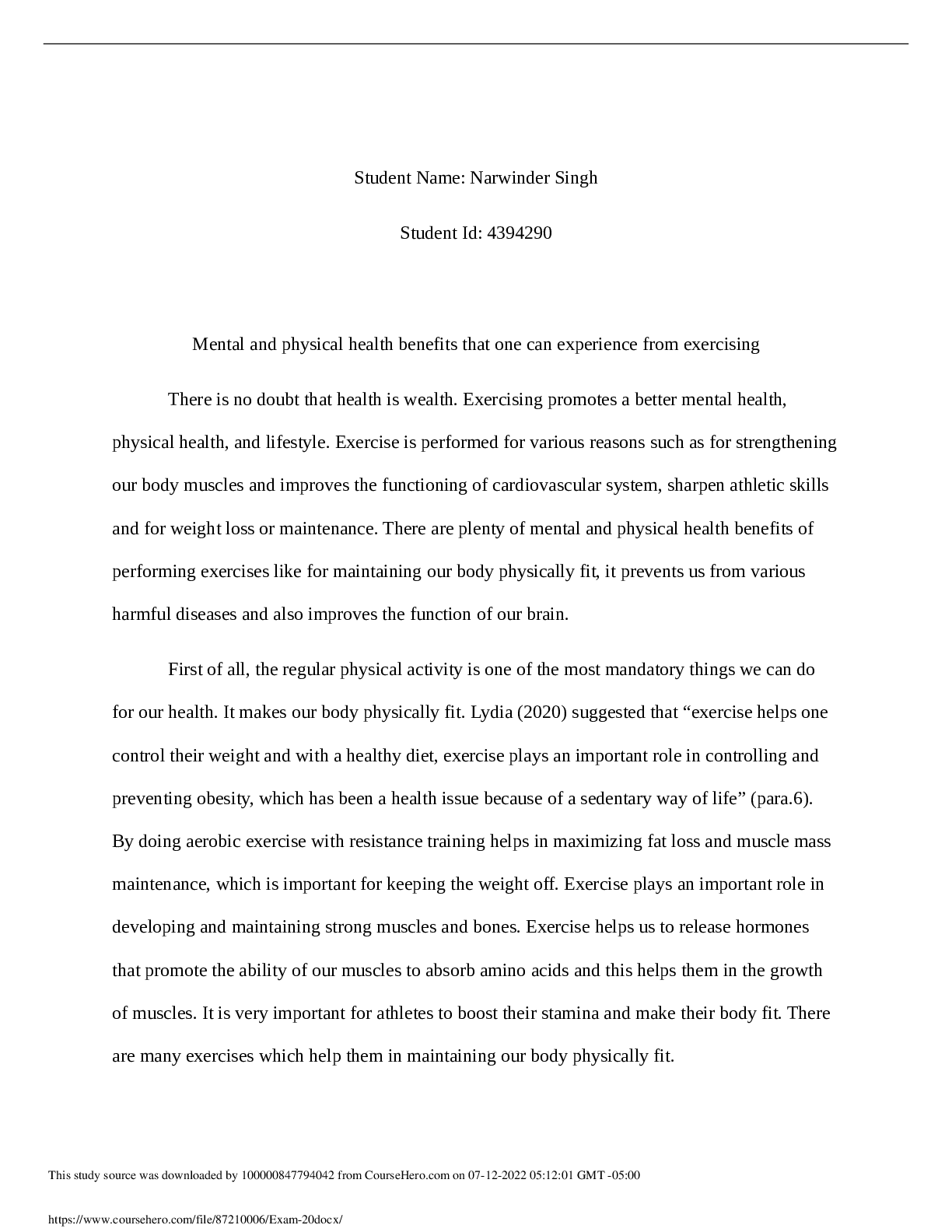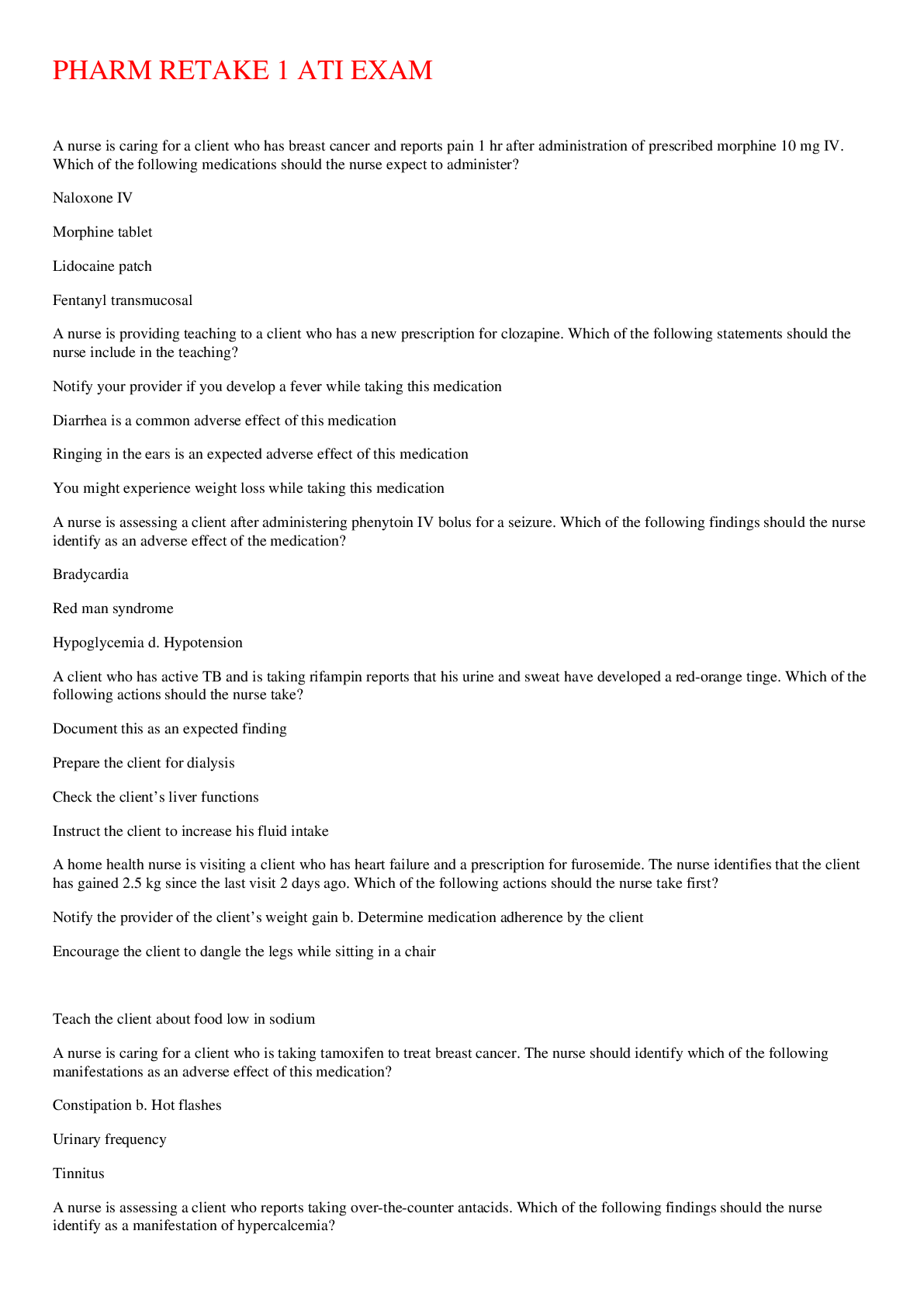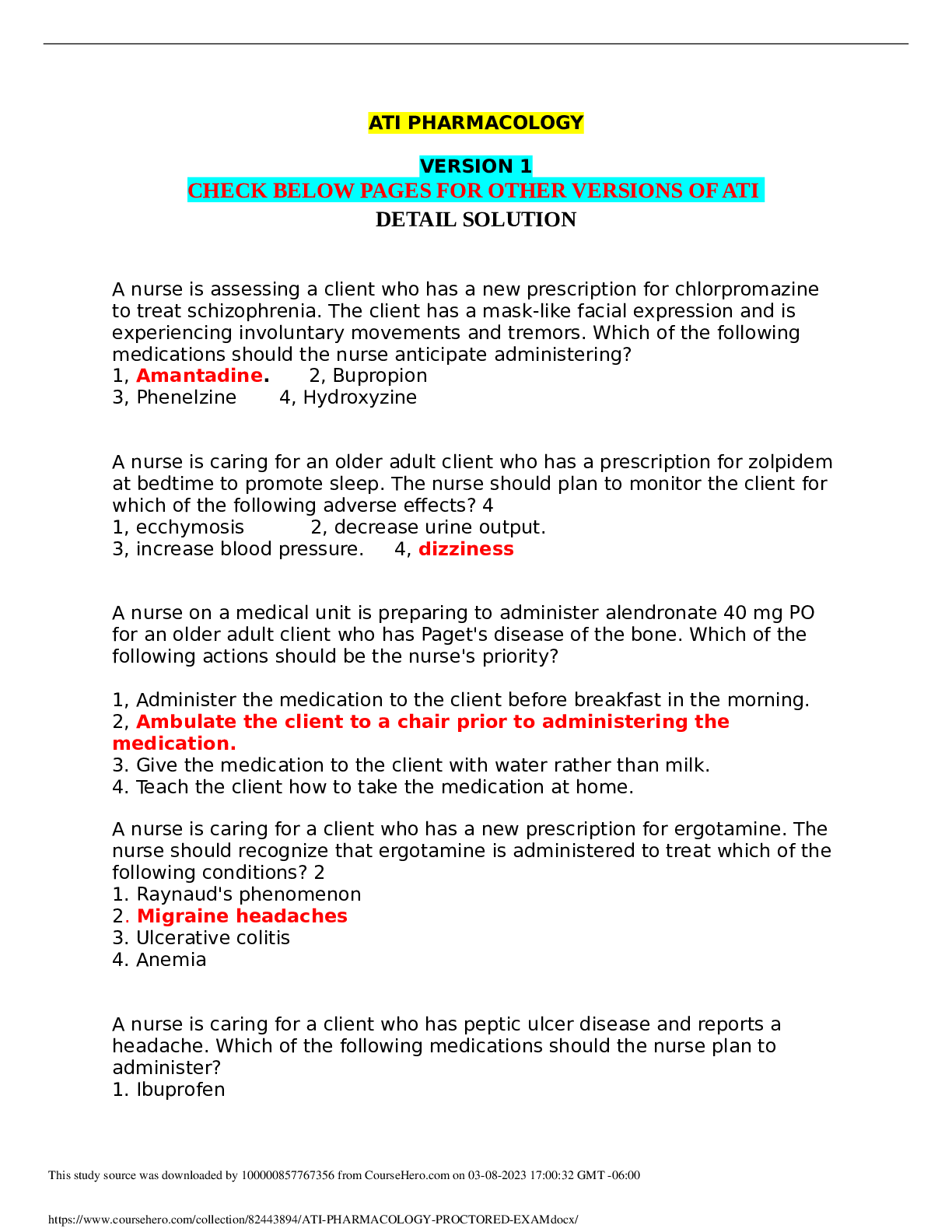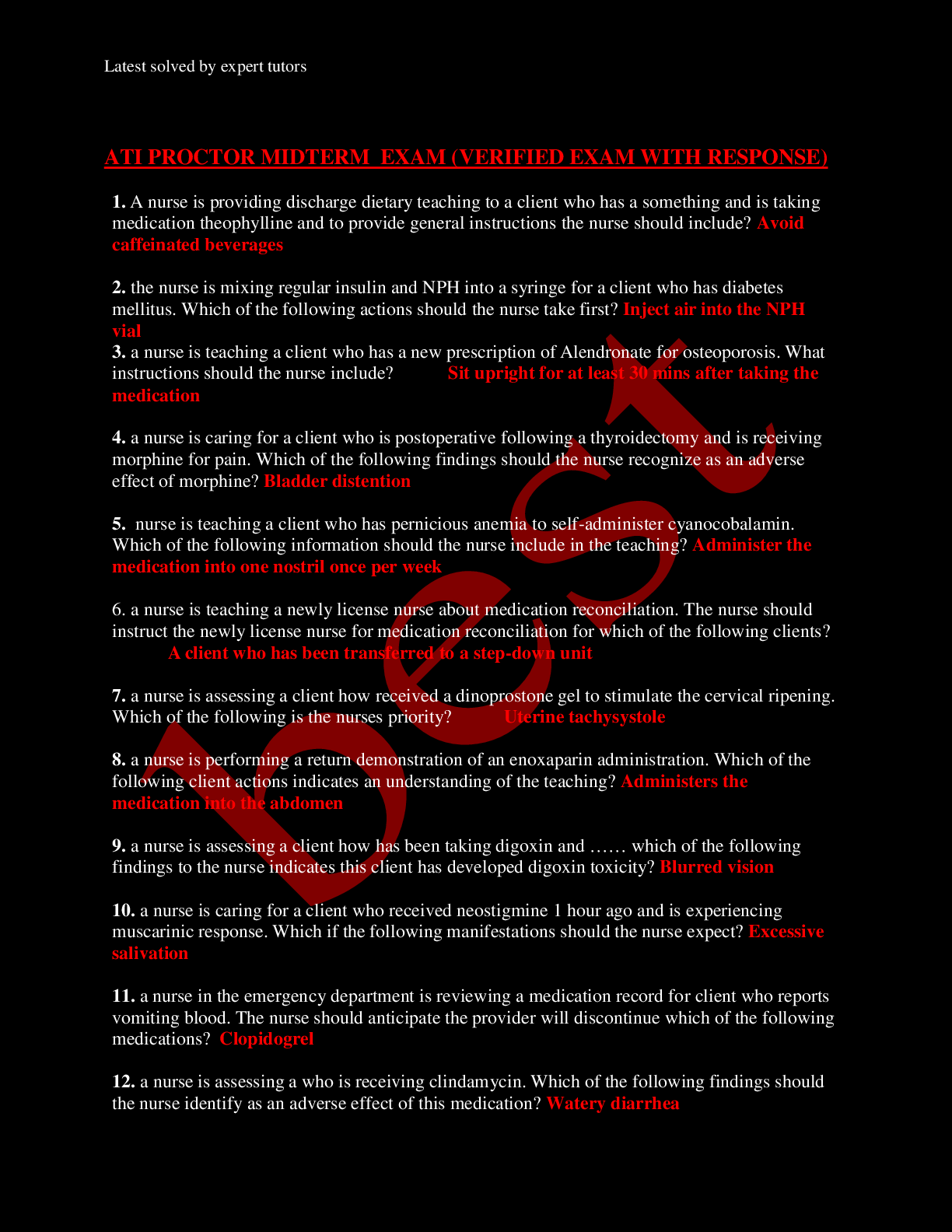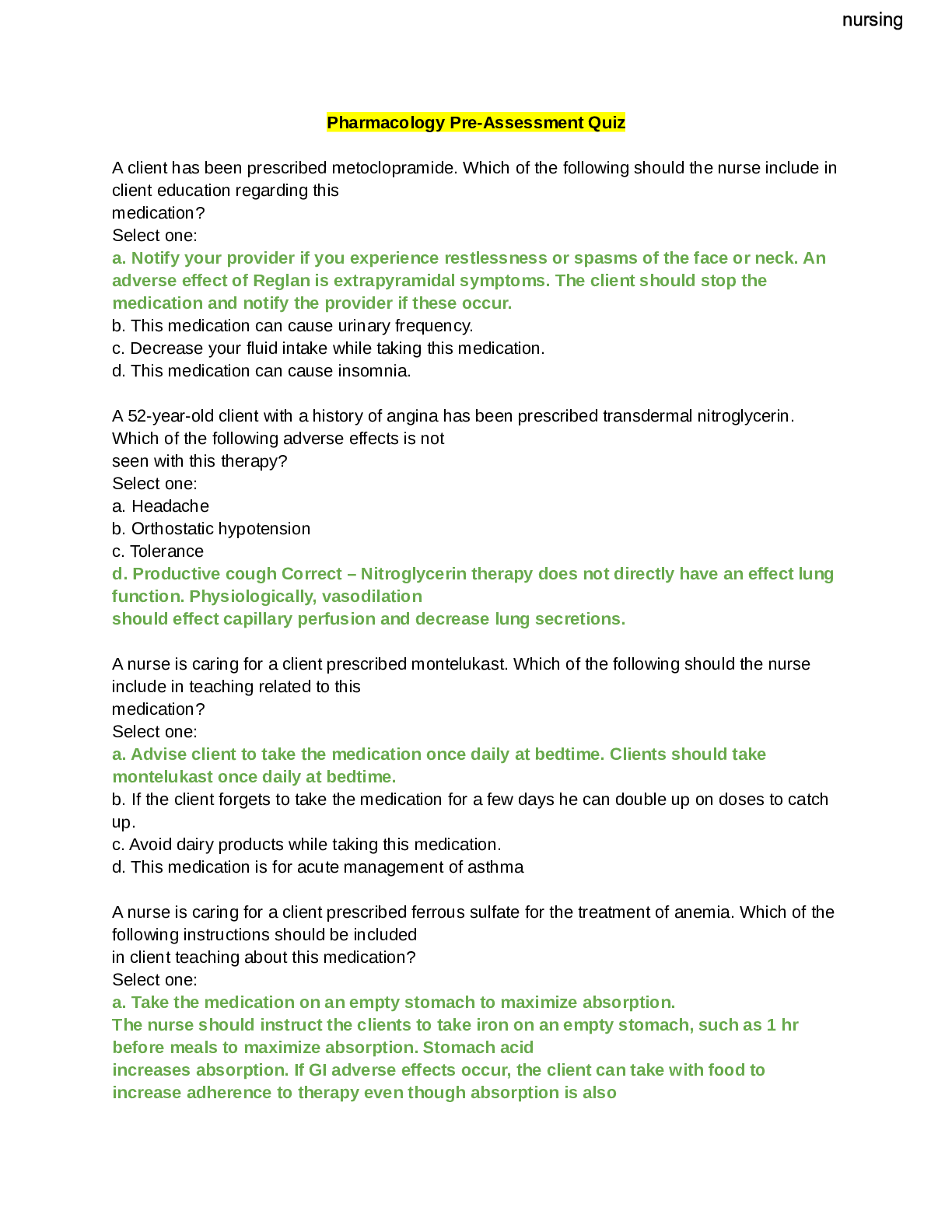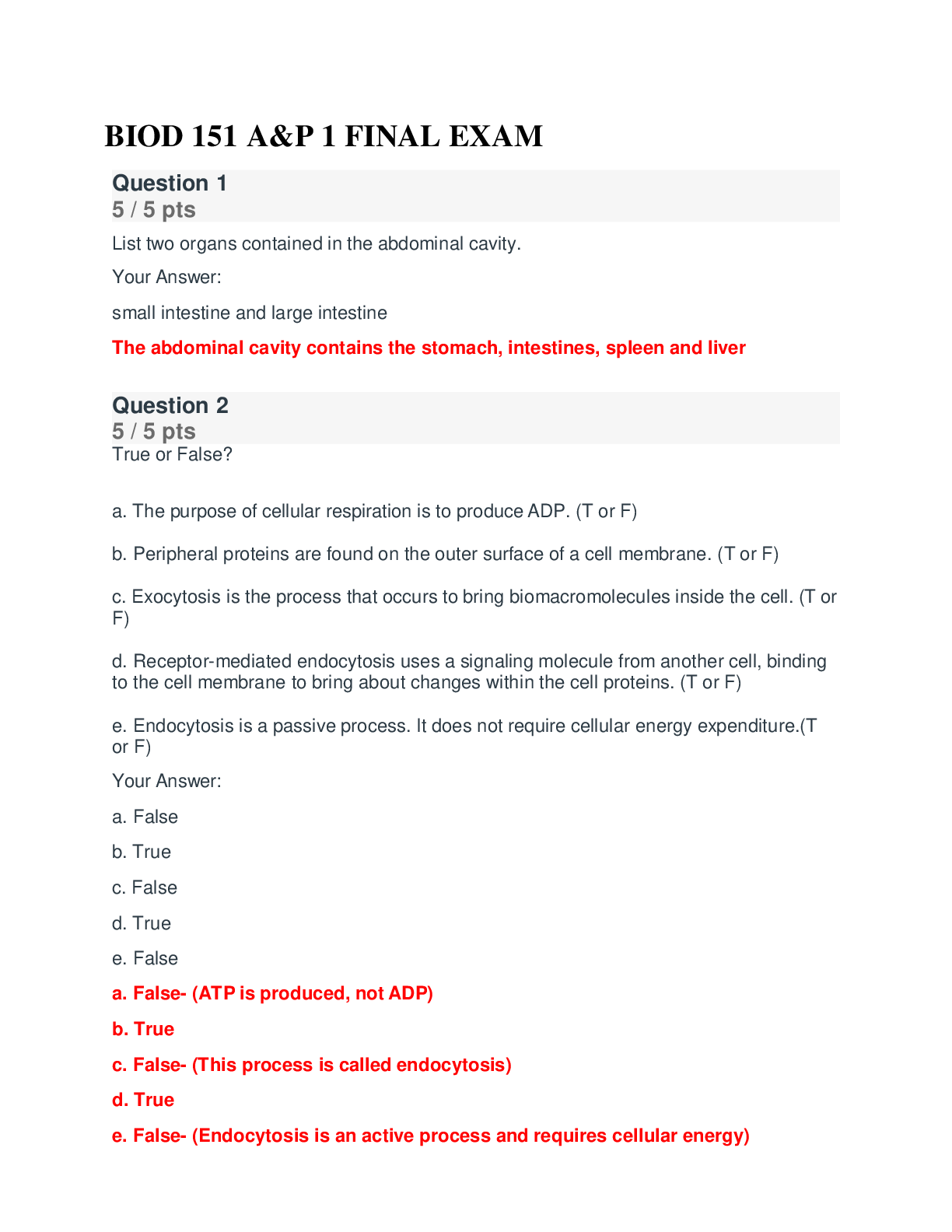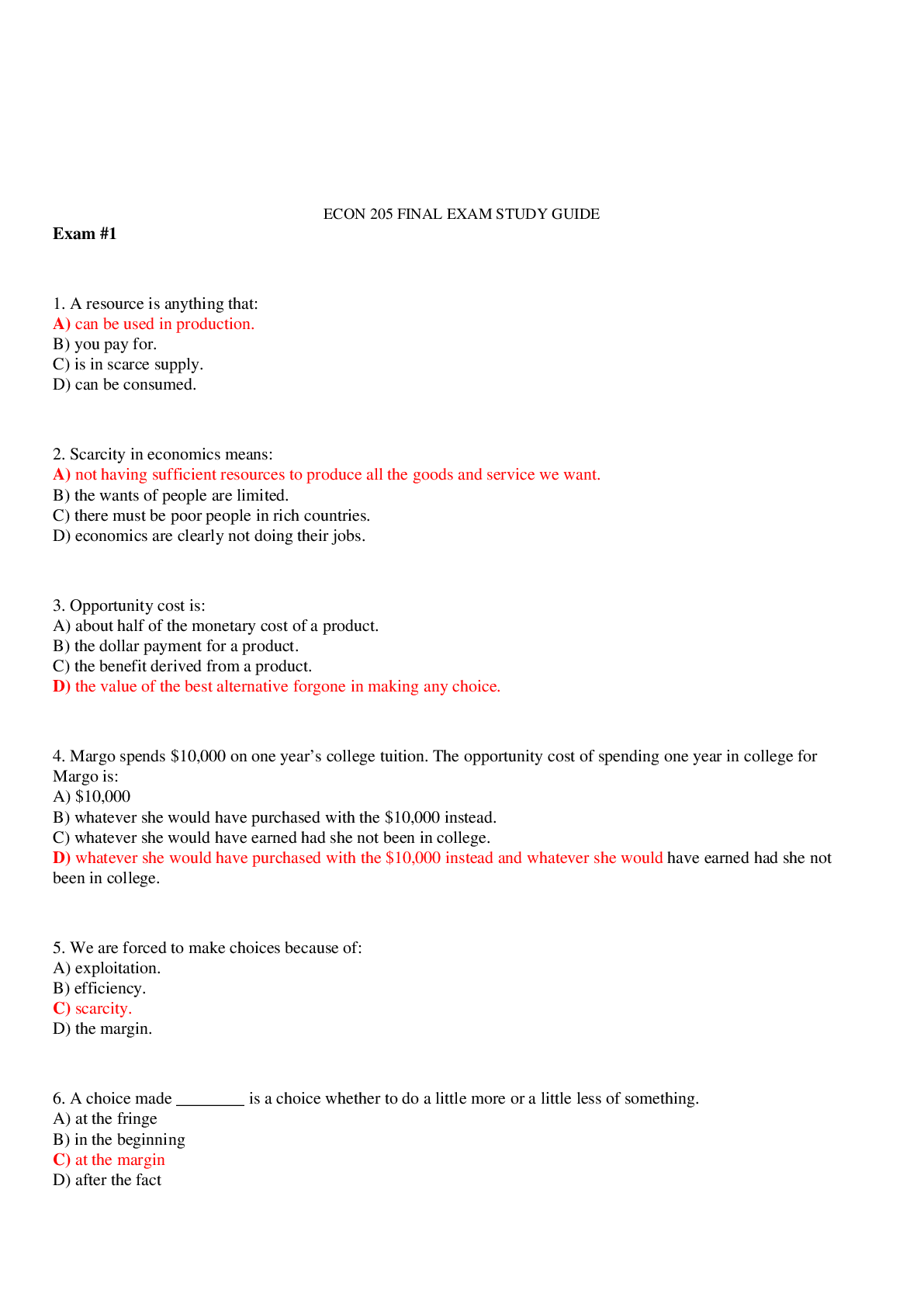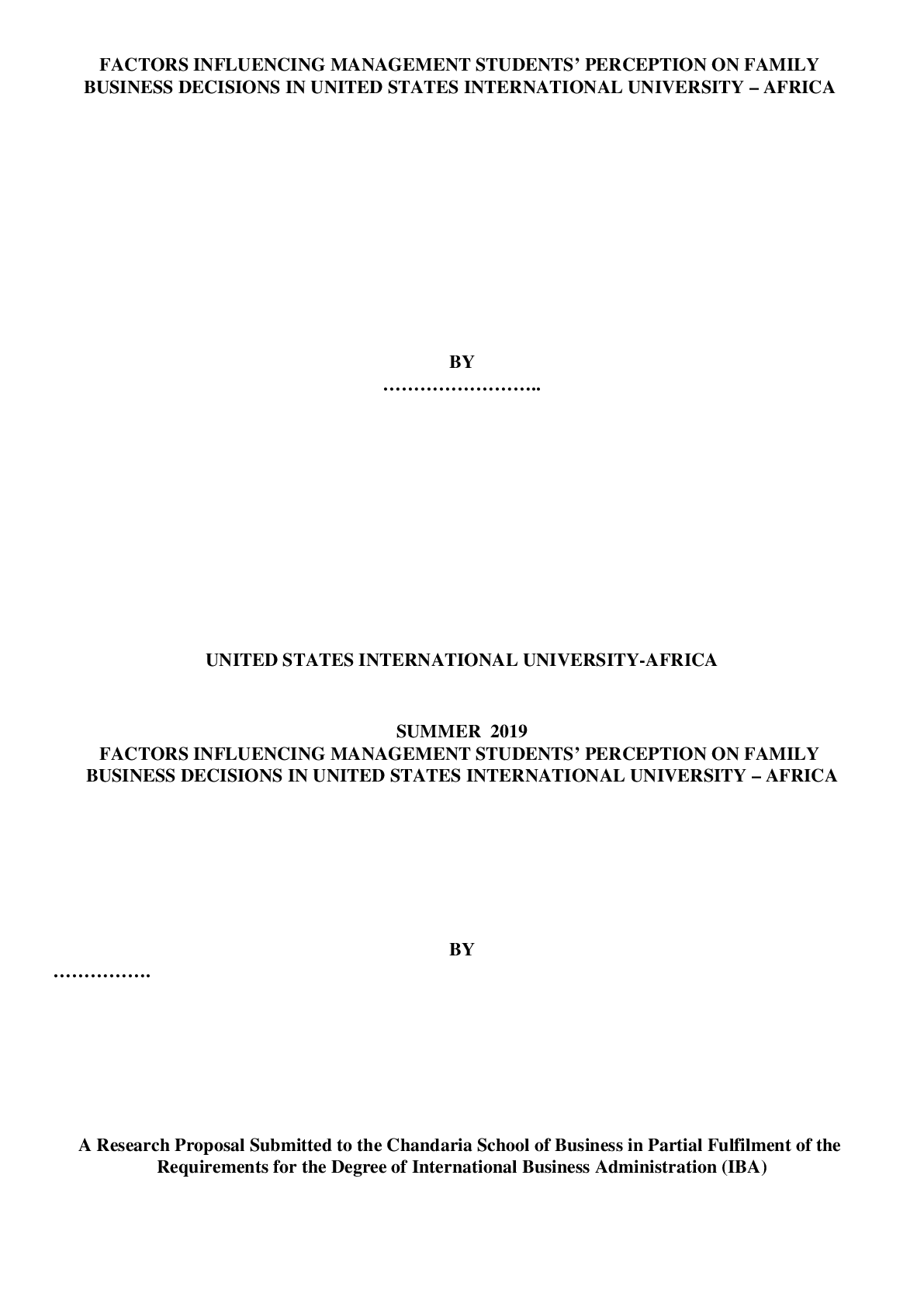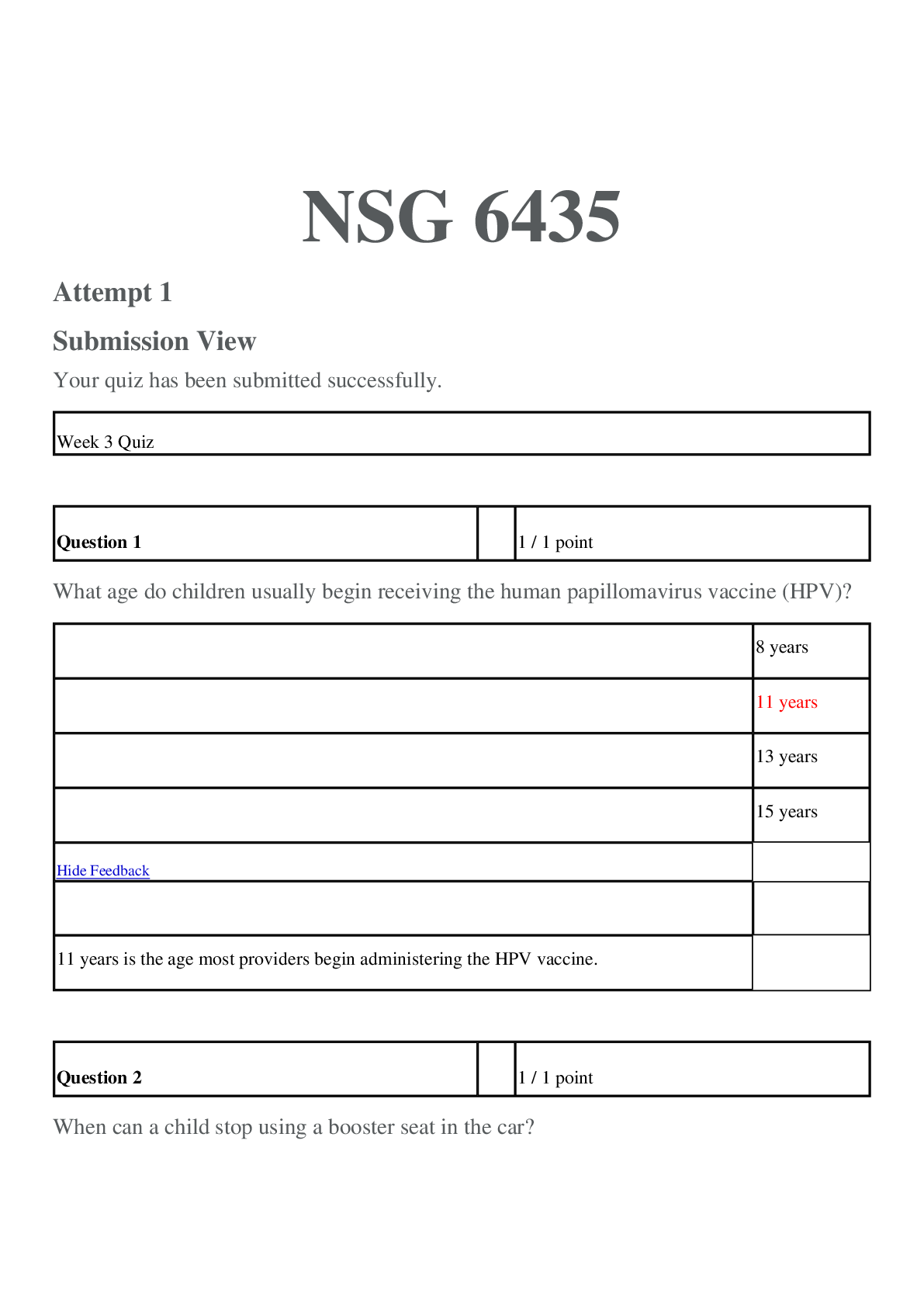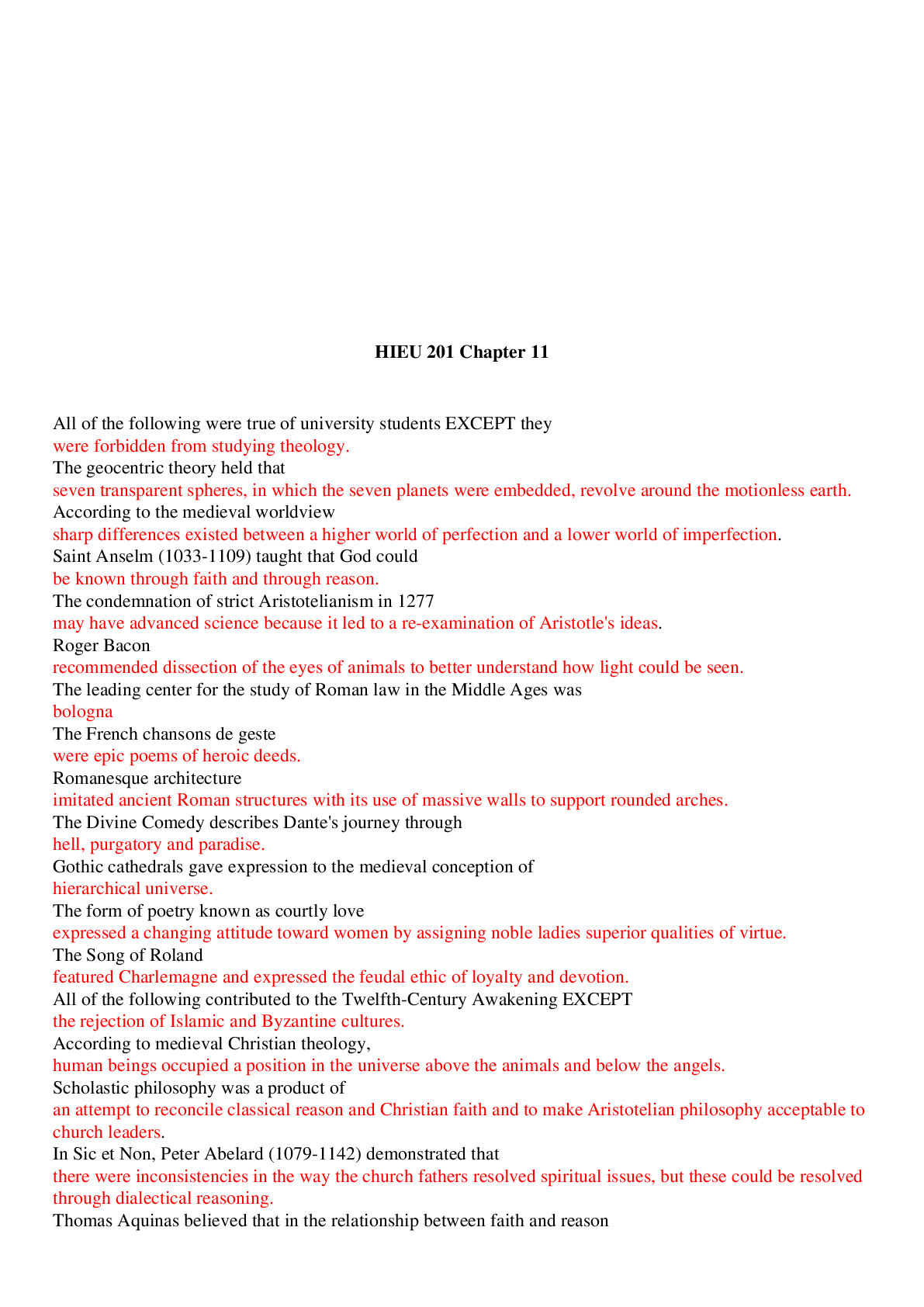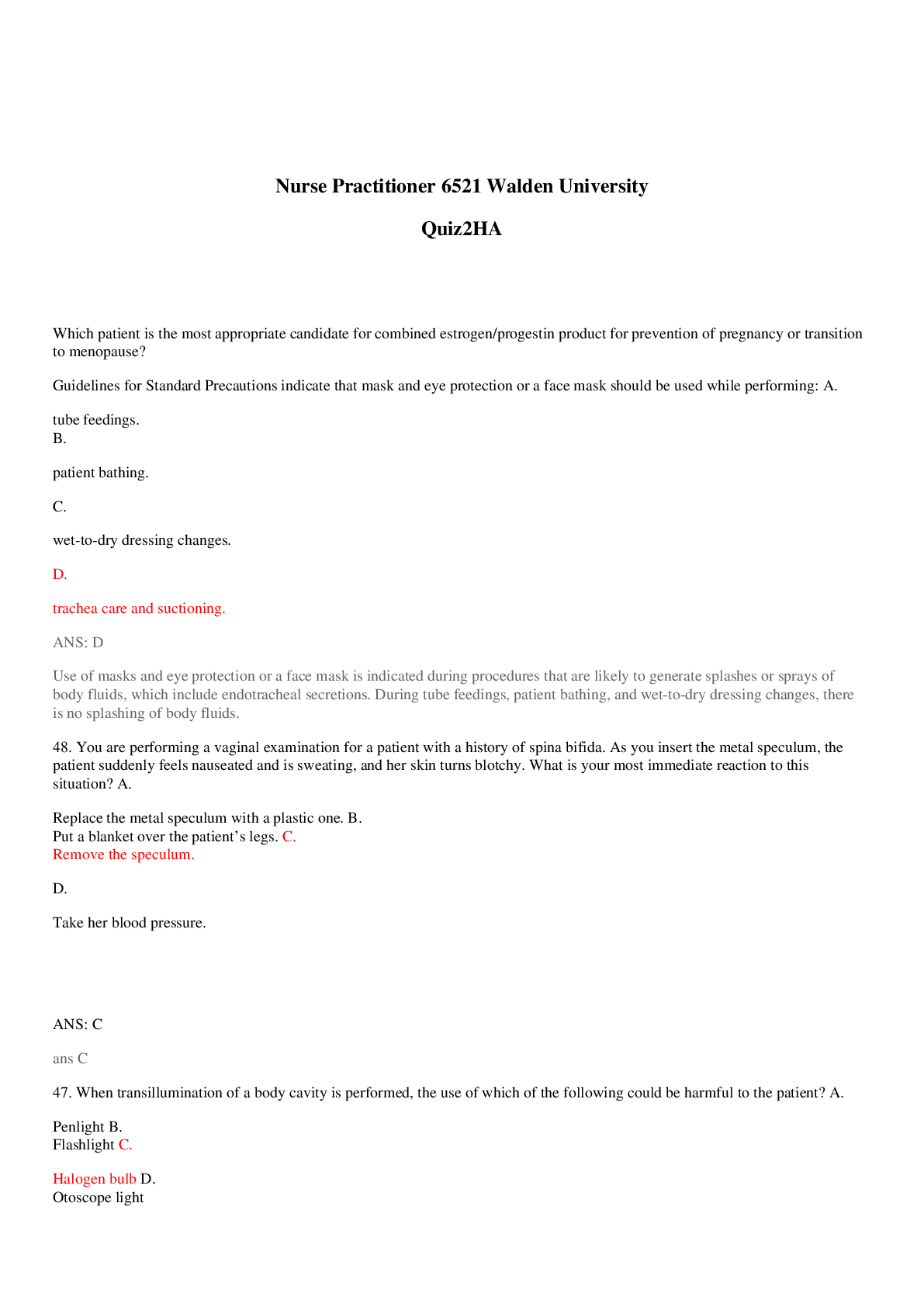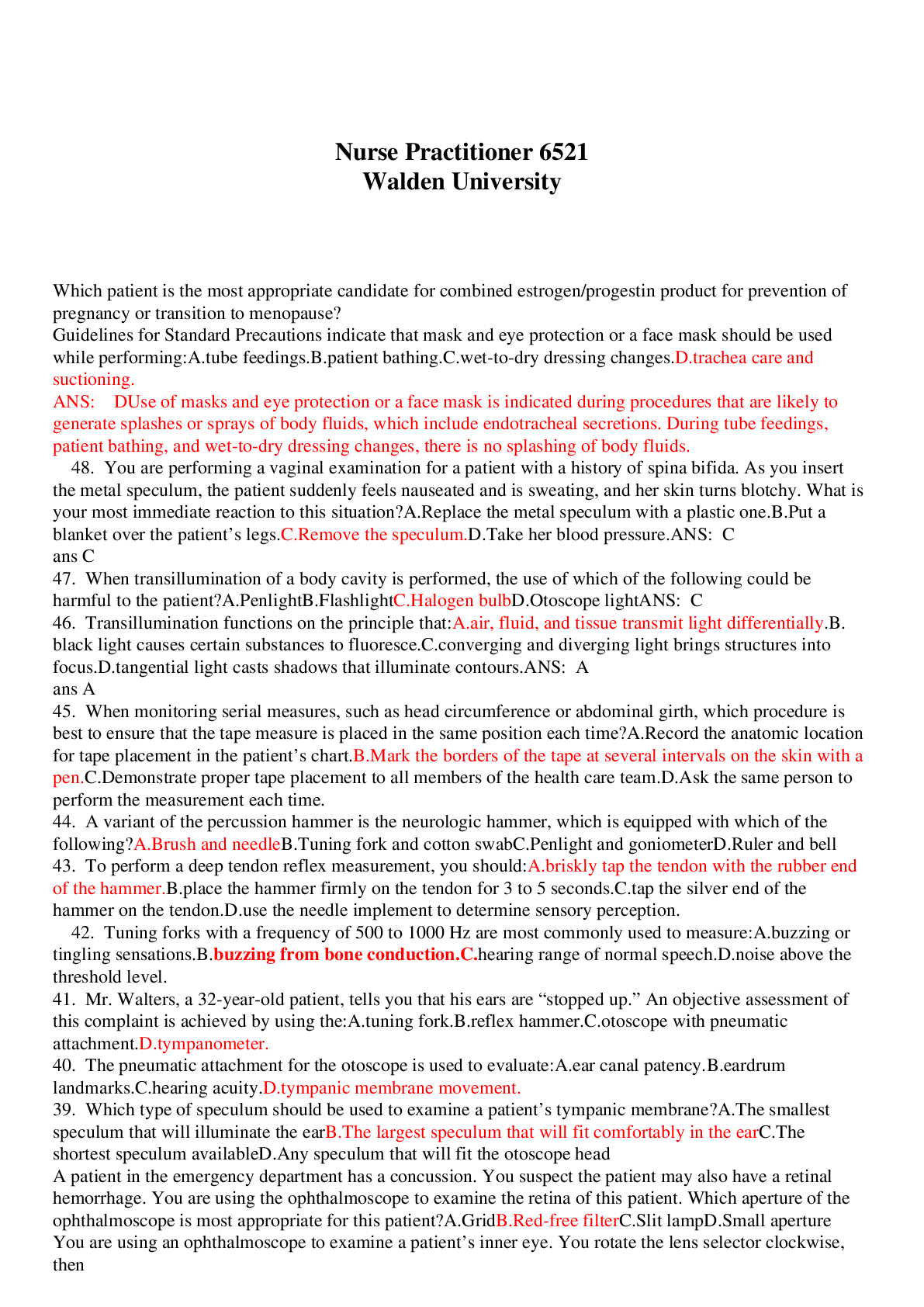LEAPMED_MOCK_EXAM_COMPILED||EXAM REVIEW|| 100% CORRECT
Document Content and Description Below
EAPMED REVIEW MOCK EXAM – BIOLOGY PART 1 1. Chromosomes become most distinct during cell a. reproduction c. metabolism b. respiration d. transpiration 2. In which pair of organelles are ligh... t and chemical energies transformed? a. centriole and ribosome b. chloroplast and lysosome c. chloroplast and mitochondrion d. golgi apparatus and microtubule 3. Which of the following is the function of the nuclear membrane? a. it controls the activities of the cell. b. it encloses the cytoplasm. c. it surrounds the nucleus. d. it supplies energy for the cell. 4. The chemical responsible for most synaptic transmission in neurons is the a. adrenaline b. choline c. noradrenaline d. acetylcholine 5. Which stages of cellular division have exactly opposite characteristics? a. prophase and telophase b. prophase and anaphase c. metaphase and telophase d. metaphase and anaphase 6. The continued synthesis of protein requires the continued synthesis of its corresponding a. trna b. nrna c. mrna d. nucleic acid 7. Which of the following results in the complete oxidation of a substrate to ATP + CO2 + H2O? a. glycolysis b. fermentation c. aerobic respiration d. Anaerobic respiration 8. Enzymes are important to the life of cells because they a. speed up chemical reactions in the cells b. increase the amount of products of chemical reaction c. provide the energy necessary for reactions to occur d. provide the substance for the reactions in the cells 9. Plant cells will not break when placed in a container with plenty of water due to the presence of a. a membrane that regulates the flow of water b. the cell wall that supports the membrane when it is turgid c. the cytoplasm that can absorb much water d. organelles that expel excess water 10. Which of the following is true about catalyzed reactions in cells? a. the catalyst itself becomes involved in the reaction. b. the catalytic efficiency of enzymatic reactions is extremely high. c. the catalytic efficiency of enzymatic reactions is moderately low. d. enzymes cause uniform reaction. 11. Which activity does NOT require cellular energy? a. synthesis of hormones b. contraction of muscles c. coordination of electrochemical impulses d. diffusion of sodium chloride through blood plasma 12. Which feature is present in eukaryotic cells but NOT in prokaryotic cells? a. chromosome b. cytoplasmic membrane c. nuclear membrane d. nucleolus 13. The hormone progesterone a. stimulates follicle growth b. stimulates FSH production c. is produced by the anterior pituitary d. readies the uterus for implantation 14. Which of the following are present in both prokaryotic and eukaryotic cells? a. Lipid-protein cell walls b. Cytoplasmic and nuclear regions c. Distinct nuclear envelopes d. Circular chromosomes of DNA 15. Which of the following correctly describes the Na+ and K+ ions across the cell membrane? a. The concentration of Na+ ions outside the cell is high and the concentration of K+ ions outside the cell is low. b. The concentration of Na+ ions outside the cell is low and the concentration of K+ ions inside the cell is low. c. Inside the cell, the concentrations of Na+ and K+ ions are both high. d. Outside the cell, the concentrations of Na+ and K+ ions are both high. 16. What is the correct sequence of the different stages in blood clotting? a. I, II, IV, III b. II, I, IV, III c. IV, II, I, III d. IV, I, II, III 2 LEARNFAST REVIEW AND TUTORIAL HUB 17. Which of the following is most likely to occur when a cell is placed in a hypertonic solution? a. Hemolysis b. Plasmolysis c. An increase in turgor pressure inside the cell d. A decrease in solute concentration inside the cell 18. The function of manufacturing is common in which of the following groups of organelles? a. Microtubules, mitochondria, and Golgi apparatus b. Chloroplasts, lysosomes, and endoplasmic reticula c. Golgi apparatus, cell membrane and chloroplasts d. Ribosomes and chloroplasts 19. Fatty acids are broken down initially by a process known as a. glycolysis b. transamination c. beta-oxidation d. pentose phosphate pathway 20. Which of the following cellular structures is related to protein synthesis? a. Lysosome b. Nucleolus c. Mitochondrion d. Golgi apparatus 21. The carbon dioxide produced by living organisms comes from the a. inhaled oxygen which reacted with carbon in their bodies b. foodstuffs ingested by the organisms c. water which reacted with carbon in their bodies d. glucose in their bodies 22. In pulmonary circulation in mammals, the veins carry a. oxygenated blood away from the heart b. oxygenated blood toward the heart c. deoxygenated blood away from the heart d. deoxygenated blood toward the heart 23. Destruction of all beta cells in the pancreas would cause a. glucagon secretion to stop and a decrease in blood glucose. b. glucagon secretion to stop and an increase in blood glucose. c. insulin secretion to stop and an increase in blood glucose. d. insulin secretion to stop and a decrease in blood glucose. 24. In the initial digestive process in man, all of the following occur in the mouth EXCEPT a. secretion of enzymes b. primary carbohydrates digestion c. fats and protein digestion d. conversion of food into smaller pieces 25. The growth reaction of plants to gravity is called a. thigmotropism b. thermotropism c. heliotropism d. geotropism 26. The function of mucus secreted by the lining of the alimentary canal is to a. help digest fats into fatty acids and glycerol b. help increase the amount of juices secreted by the digestive glands c. protect the lining from being acted upon by the digestive juices d. prevent bacteria from reaching the blood vessels 27. Which of the following is the organism Archips rosana most closely related to? a. Rosana pinuta b. Archips fervidiana c. Pinuta archips d. Fervidiana rosana 28. When inhaled, which substance can form a more stable compound with hemoglobin, thereby causing adverse reactions in an individual? a.Ether b. Nicotine c. Carbon dioxide d.Carbon monoxide In items 29 and 30, refer to the following setups: [Show More]
Last updated: 1 year ago
Preview 1 out of 12 pages
Instant download
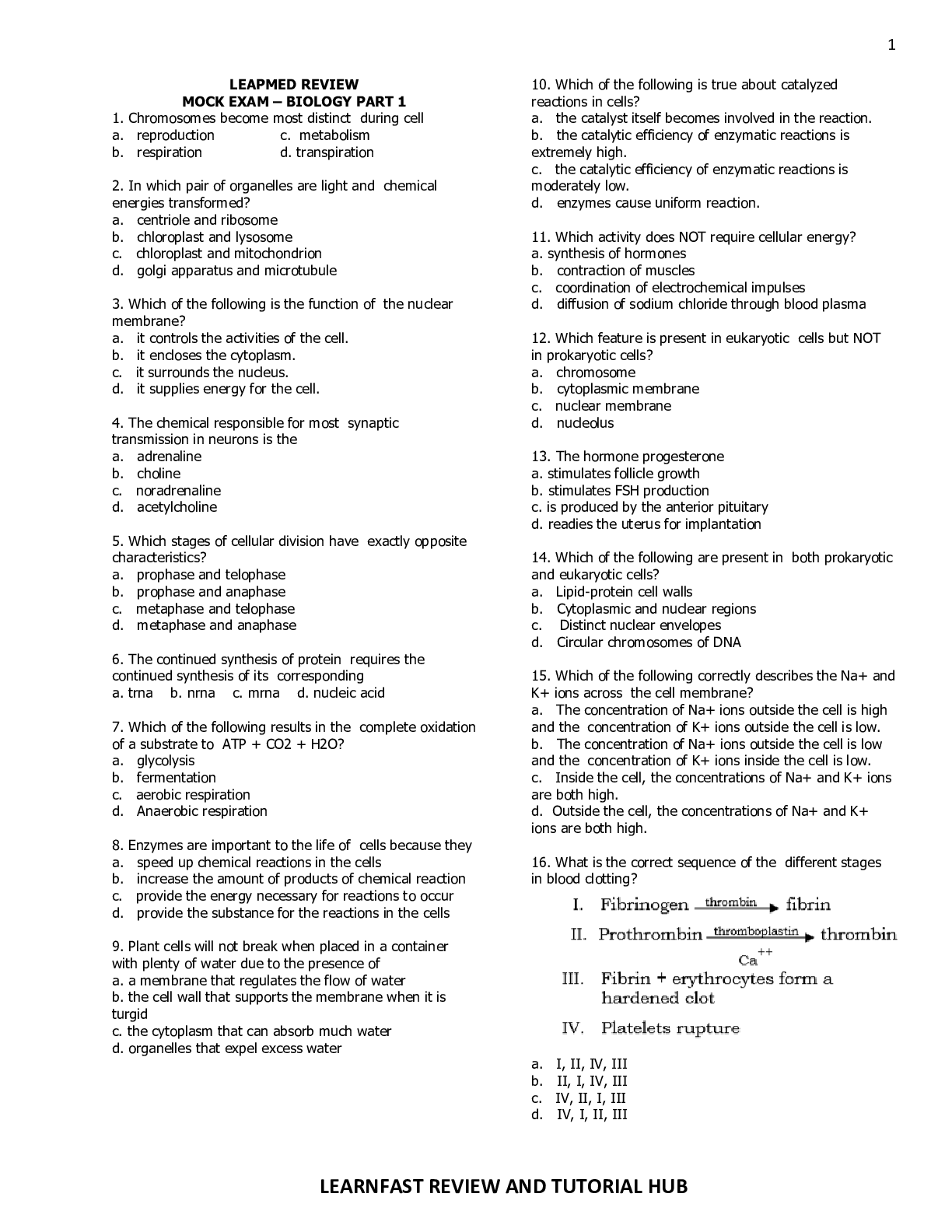
Buy this document to get the full access instantly
Instant Download Access after purchase
Add to cartInstant download
Reviews( 0 )
Document information
Connected school, study & course
About the document
Uploaded On
Jul 05, 2022
Number of pages
12
Written in
Additional information
This document has been written for:
Uploaded
Jul 05, 2022
Downloads
0
Views
56

